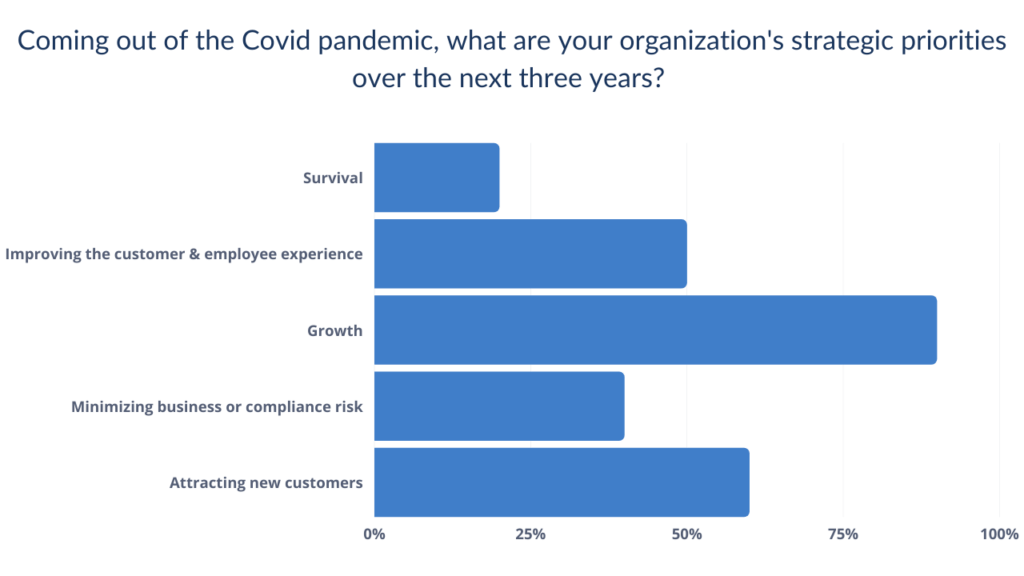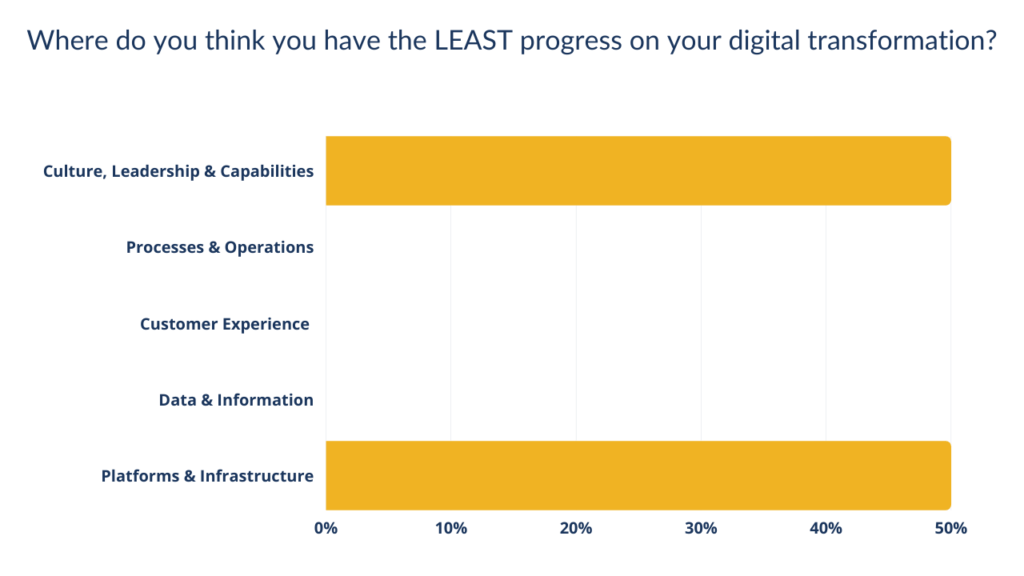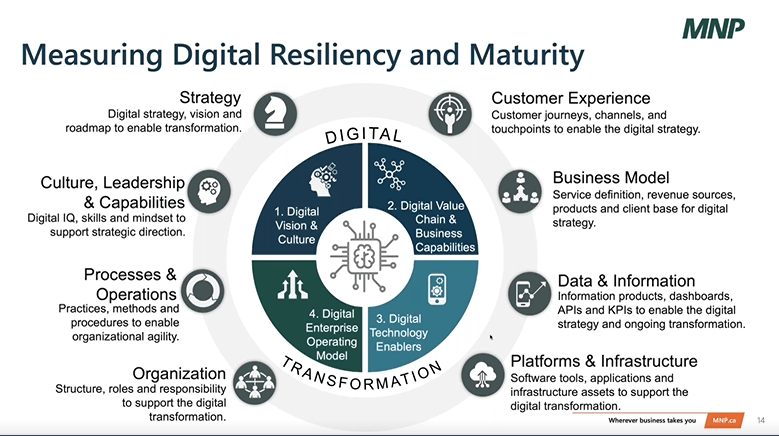The following summary is from an event we held with Sean Murphy, National Digital Leader & Partner in MNP’s Consulting and Technology Solution practice in Ottawa, Canada. Sean has more than 25 years of business solution implementation experience and helps client’s architect and implement strategic change and digital transformation initiatives.
Digital transformation requires more than just having the right technology in place. Companies must build resilience into their culture by implementing agile tools and methods into everyday processes. It takes commitment and support from the entire organization to build a resilient company that is able to adapt to ever-changing market demands and disruptions. CSO Online emphasizes that “digital resilience represents a fundamental change in the way we understand digital technology, risk, and opportunity” and delivers an organization that can move quickly, adapt easily, and recover effectively, even when things go wrong.
We recently hosted a fireside chat with Digital Technology leader, Sean Murphy, on Moving Towards Digital Resilience. Through audience polling and panelist insights, we were able to uncover key learnings on how companies can build business and digital resilience into their culture by encouraging a growth mindset and adapting to change through various strategies, such as experimentation, transparency, and fluid team structures.. During the event, Sean and VistaVu’s Vice President of Consulting & Growth, Tony Balasubramanian, sat down to discuss how business models are shifting and what companies can do to future-proof their workforce through actionable steps.
Audience engagement in the form of poll questions helped to reinforce real world strategies that mid-market companies are implementing today in their digital transformation.
Based on the discussion here are 4 actionable steps to help your company become more digitally resilient.
1) Understand where you are now as an organization
Companies often underestimate the progress that they have made towards becoming more digitally resilient. Sean defines digital resiliency as “the ability for an organization to rapidly adapt to business disruptions by leveraging digital capabilities to not only restore business operations, but also capitalize on the changed conditions.”
COVID-19 has demonstrated that we as a business community are more digitally resilient than we thought. When forced to make changes due to mandatory restrictions and supply chain disruptions, companies reacted quickly with new policies and procedures. These included:
- Curbside pickup for retail & restaurants
- Immediate adoption of PPE & plexiglass
- Shift to online platforms, such as Zoom or Teams
- eCommerce focus
Companies that not only adapted but capitalized on changing conditions, by implementing new processes and technology, are reaping the rewards today. To establish where your company is coming out of the pandemic, ask yourself:
- What process changes did our company make over the past year?
- What technology did we implement?
Most importantly, you need to identify what changes you plan to keep and capitalize on now that recovery has started. When polled, our audience identified Growth (90%) as their biggest strategic priority coming out of the pandemic.

Those that understand (and can leverage) what worked well during the moments of disruption will be best positioned to experience growth and propel themselves past the competition once normalcy is restored.
2) Create pockets of fresh thinking within your organization
One benefit of disruption is the necessity for new ideas and fresh ways of thinking. Adopting a growth mindset, which can be thought of as a series of smaller objectives that help you to become more agile, is vital to becoming more digitally resilient.
Fresh ideas do not just come from the top. As a leader in your company, you must challenge the way your company works by creating an environment where creativity and experimentation is encouraged. When asked, ‘Where do you think you have the LEAST progress on your digital transformation’, our audience members identified Culture, Leadership & Capabilities (50%) as a major laggard in their company.

How you operate as an organization in terms of culture, skills and mindset is the most important part of building a strategic and resilient company. When measuring digital resiliency, Sean evaluates 8 key factors:
- Strategy: digital strategy, vision & roadmap
- Culture, Leadership & Capabilities: digital IQ, skills & mindset
- Processes & Operations: practices, methods, and procedures to enable organizational agility
- Organization: structure, roles & responsibilities
- Customer Experience: customer journeys, channels & touchpoints
- Business Model: service definition, revenue sources, products & client base
- Data & Information: information products, dashboards, APIs & KPIs
- Platforms & Infrastructure: software tools, applications, and infrastructure assets

Often, technology is overemphasized as the end all solution to a company’s problems. However, as you can see here, 6 out of 8 of these focus points have nothing to do with technology. While you won’t be successful without the right technology in place, you must first adjust your company’s culture to support your investments.
Provide a clear vision and purpose that employees can understand and rally behind. Have a common goal and direction in place to help align all departments and encourage change. After you have established a clear vision, give people the freedom to think differently and try new things. Implementing a culture of trust will help your team open up to trying new things, and result in innovative ideas.
Once you have the proper foundation in place across your organization, you can start to identify areas to invest.
3) Encourage iterative experimentation
After opening your company culture to innovation and creativity, it is important to prioritize and create conditions that encourage experimentation. How can you involve your employees in the process of innovation?
The first step is changing the way teams think and operate. No longer are siloed departments scalable or efficient. Agile teams that work across boundaries on a daily basis will not only help solidify the culture, strategy and processes defined in step 2, but encourage innovative ways of thinking through shared information and transparency.
Learn to make quick decisions. The key to digital resilience is “rapidly adopting to business disruptions” no matter how big or small these may be. By doing so, you are creating an environment where you are enabling change across departments and empowering teams to implement new ideas.
These changes don’t have to be big. Start by identifying low cost, low investment areas of change within your organization and build a business case to prove an idea towards more impactful change. Demonstrating quick wins on a small scale is key to getting management on board to invest in more large-scale initiatives.
4) Repeat & evolve
Becoming more digitally resilient is a constantly evolving effort as we embrace new technologies, data, business models, and more. The success of your company is dependent on the speed in which you can experiment with fresh ideas and how quickly you can adopt different strategies to move your business forward. It’s always better to try and fail than not to try at all.
Those that become the most resilient are constantly cycling through these steps outlined above to create a stronger company every day. If nothing else, the pandemic showed us that we are all capable of change when the necessity arises, and that we often experience unexpected benefits from rapid change. Don’t wait for external factors to push you to change, get started today so you can better control the outcome.
If you have any question on how your company can take actionable steps to become more digitally resilient, feel free to reach out to our team.
Tags:
ERP
June 15, 2021




